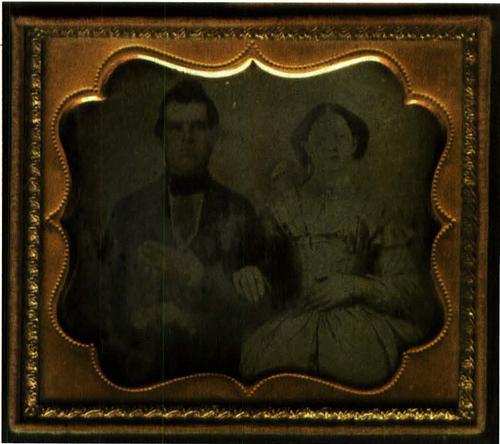Sign up for the Family Tree Newsletter Plus, you’ll receive our 10 Essential Genealogy Research Forms PDF as a special thank you!
Get Your Free Genealogy Forms
"*" indicates required fields

Brian Perkins is a very lucky genealogist. He has three out of four of his grandparents still living to help him identify family photographs. They can also help him decipher the genealogical information he found in a great-aunt’s apartment. In addition to the scraps of genealogical data she collected, he found a collection of identified photographs. He organized the material using a genealogy software program and discovered that he had photographs of seven of his 16 great-great-grandparents.
Recently, he found a daguerreotype in the possession of one of his grandparents — but this picture’s subject was not identified. One of his grandfathers did verify that it’s from the paternal side of the family. Since Perkins has images of almost half of those great-grandparents, he’s hoping to identify the couple in the daguerreotype through a process of elimination. Seeking help, he submitted a digital copy of the image to the Identifying Family Photographs feature on Family Tree Magazine‘s Web site <www.familytreemagazine.com/photos/photohelp. htm>.
Identifying photographs relies on a series of clues in the image such as photographic method, photographer’s imprint and clothing. This portrait contains many such details:
Type of photograph
Invented in 1839 and introduced in the United States in 1840, daguerreotypes have a distinctive appearance. Consisting of a sheet of polished metal, these images must be held at a particular angle in order to be viewed — otherwise you’ll end up seeing yourself in its reflective surface. Daguerreotypes remained popular until the mid-1860s. More examples of this type of photograph can be viewed on the Daguerrian Society Web site <www.daguerre.org>.
There are additional ways to narrow down a date for a daguerreotype. Most were issued with a case made of materials ranging from paper to leather, with a design imprinted in the surface; different designs appeared in various years. Mat designs also evolved from simple rectangular openings with a frosted surface to fancier designs such as the one shown here.
Clothing
The most exact way to date a photograph is through clothing. In this instance, the man is wearing an upswept hairstyle that went out of fashion in the early 1850s. His wife’s dress is clearly in the style worn circa 1850: a fan-shaped bodice with stays and cap sleeves over a semi-fitted lower sleeve. In the late 1840s and early 1850s, women wore small lace collars and their hair looped over their ears. In this photograph, the woman is not covering her ears and is wearing drop earrings — also suggesting the photograph fits that time frame.
Family data
After accumulating evidence from the details of the image, you need to go back to your family research to try to put a name with the face in your photograph. Perkins knows he’s missing pictures of five of his paternal great-grandparents. By matching the suggested time frame of the photograph, 1848 to 1852, with the life dates of his great-grandparents, an interesting pattern emerges: The only possible pair of great-grandparents old enough to be depicted in this daguerreotype was John Nicholas Perkins (1827-1906) and Mary Jesse Jones (1833-1907), who would be in their 20s by 1852. But Brian Perkins has an identified photograph of John Nicholas Perkins taken in 1870 and there’s no resemblance to the man in the daguerreotype. Could this be a picture of his great-great-grandparents instead?
The only way to determine likely suspects is to find similar facial features in the photographs you have. Perkins’ great-grandmother Mary Elizabeth Ayres (1858-1934) has the man’s square jaw, mouth and nose, which suggests this is a daguerreotype of her parents, John Grigsby Ayres (1829-1893) and Martha Jane Wilmore (1833-1894). Further support for this identification is that Ayres and Wilmore were married Oct. 24, 1852. Of course, the best chance for an actual identification is to locate other pictures of his paternal great-grandparents, his great-great-grandparents and their children for other clues.
Unfortunately, photo identification is limited by the amount of information contained in the image and what can be verified through research. Close examination of a photograph with a magnifying glass can reveal small details that help in the process, but finding an identified picture in a distant relative’s collection or through striking resemblances is your best chance of putting a name to an unknown portrait.
From the October 2002 issue of Family Tree Magazine
ADVERTISEMENT

